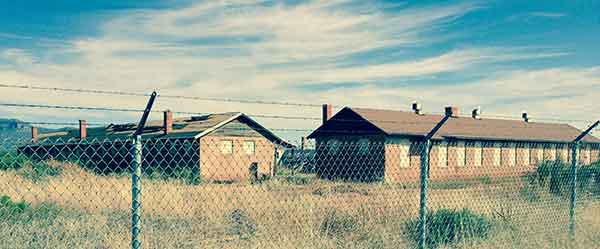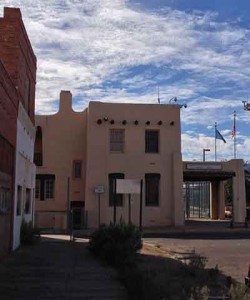
(This tour is an add-on for the Greater Bisbee and Mining Landscape tours. It requires an additional 35-40 minutes. This tour stays in the United States; it does NOT go into Mexico.)
A geographical happenstance that flavors Bisbee’s character is its proximity to Mexico, which lies less than 10 miles to the south. From the San Jose area of Bisbee, it’s less than five minutes to the border town of Naco.
Naco dates to the beginning of the 20th century, when it was create as a railhead for a line that was to be run to the Mexican city of Nacozari to the southeast, another copper-mining area. That railroad would not come about, but Naco soon became the border-crossing point for another Mexican copper mine at Cananea to the southwest.
There are actually two Nacos, one on each side of the border, the one in Mexico being larger by far.
Mexican Revolution
Naco provided considerable action for Bisbee residents over the years in more ways than one. During the Mexican Revolution (1910-1920), several pitched battles took place on the other side of the line, but a bit of it spilled across from time to time. Thousands of Americans traveled to Naco just to watch the fighting, totally disregarding the dangers.

That led to the establishment of a U.S. military presence on the border for many years. Eventually the Army built a cantonment, known as Camp Naco, just a few hundred yards from the border, to give some small comforts to the soldiers stationed there. Most of these troops were the famous Buffalo soldiers, which were based at Fort Huachuca 25 miles to the west.
Camp Naco was taken over by the CCC, the Civilian Conservation Corps, during the Great Depression, which made a number of improvements. Much of Camp Naco remains today, and an effort is under way to preserve the old adobe buildings, the last remnants of border protection during the teens.
Naco during Prohibition
Naco, Mexico, played a different role during Prohibition, when many from Bisbee made regular trips south of the border for dining, drinking and dancing. Today, Naco is the site of a significant length of the controversial border fence, a part of the national effort to control illegal immigration and drug traffic.
Also at Naco is Turquoise Valley Golf Course, the “oldest golf course in Arizona”, which recently celebrated its centennial. It is home of the Rattler, a 747-yard, Par 6, the only Par 6 golf hole in Arizona.
Naco also is known for a 1940s discovery of a Clovis Man kill site, dating back some 10,000 years. Bones of “Pleistocene megafauna,” such as the mammoth, were excavated here in the 1950s, one of the first such excavations in the country.
